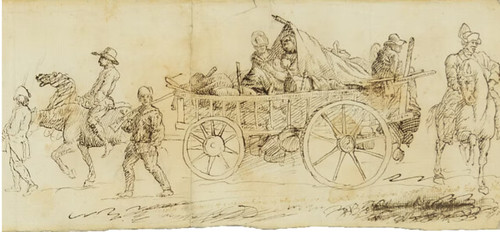
PREV ARTICLE
NEXT ARTICLE
FULL ISSUE
PREV FULL ISSUE
DU SIMITIERE SKETCH DISCOVEREDMichael Oppenheim forwarded this Washington Post article about the discovery of a rare Revolutionary War drawing by an important colonial figure with a numismatic connection - Pierre Eugene Du Simitiere was an early collector and founding father of American numismatics that Joel Orosz wrote about in his 1988 book, The Eagle that is Forgotten. -Editor After waiting for two years, Matthew Skic was excited to visit the New York City apartment of a collector of early American art. The curator of exhibitions at the Museum of the American Revolution in Philadelphia had heard reports about Judith Hernstadt's impressive array of artifacts from the colonial period, which she had gathered over the past 40 years. Because of the covid pandemic and other commitments, Skic had to delay his tour until August 2023. His patience was rewarded when he witnessed Hernstadt's assemblage of prints, paintings, furniture and other rare items from the late 18th century.
Then Hernstadt took him into another room, and when he saw a framed image hanging on the wall, he recalled, It was a pen-and-ink sketch of 18th-century soldiers walking next to a horse-drawn wagon that included two women and a baby. Depictions of an army on the march from that era were rare. He wasn't sure which army it was until he spotted an important clue.
Skic would later discover that — unbeknownst to Hernstadt — she was in possession of one of the earliest eyewitness depictions of American troops and their female companions during the Revolutionary War. The drawing had been crafted by an artist who played a prominent role in the iconography of the new American government, though neither Hernstadt nor Skic was aware of it at that moment. Until Skic's discovery, the oldest known artwork depicting female camp followers was a watercolor from 1782 by Pierre Charles L'Enfant, the French engineer who laid out the street plan for Washington. In 2017, Skic had been part of the team that identified L'Enfant as the artist who created a panoramic painting of Washington's army at West Point, N.Y. He wondered if L'Enfant could have also drawn Hernstadt's sketch, but historical records showed he had not been in Philadelphia in 1777. Skic continued searching for the artist and settled upon a prime suspect: Pierre Eugene du Simitiere. The Swiss-born philosopher and artist had settled in Philadelphia in 1774. Five years later, he completed one of the first known portraits of George Washington, which was featured on the 1791 one-cent coin.
Skic was familiar with the artist. In 2013, as an intern, he had studied the works of du Simitiere, who was best known for submitting the first proposed design for the Great Seal of the United States. Though his idea was rejected, the Founding Fathers seized on two elements of his design: the phrase The museum curator consulted with art historians familiar with du Simitiere's other works, then presented samples of the artist's letters to handwriting experts so they could compare them to the inscription on the sketch. In February, Skic and his colleagues announced their finding: It was du Simitiere. Joel Orosz writes: "Many thanks for sharing news of this cool find! These pen and drawings have Du Simitiere's signature you-are-there look, and also his customary thriftiness, being drawn on both sides. I'm glad they have ended up in the Museum of the Revolution, which is where they truly belong."
To read the complete articles, see:
To read earlier E-Sylum articles, see:
Wayne Homren, Editor The Numismatic Bibliomania Society is a non-profit organization promoting numismatic literature. See our web site at coinbooks.org. To submit items for publication in The E-Sylum, write to the Editor at this address: whomren@gmail.com To subscribe go to: https://my.binhost.com/lists/listinfo/esylum All Rights Reserved. NBS Home Page Contact the NBS webmaster 
|
